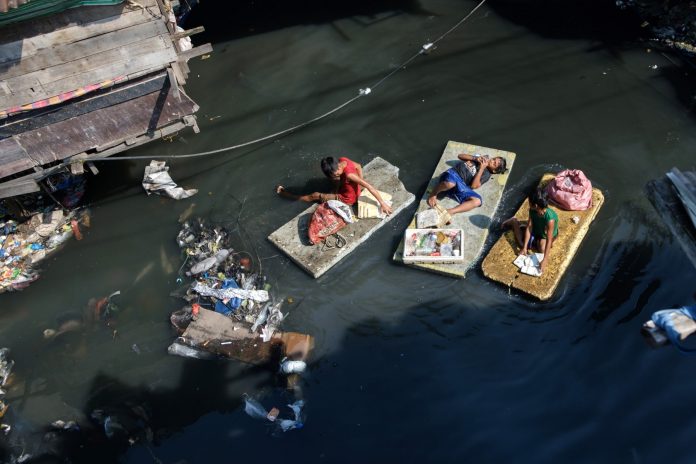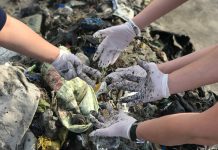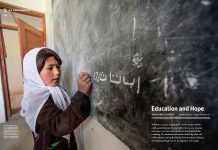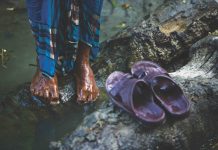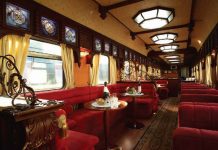Living off the bounties of pollution
Text Joe Henley
Photos Paul Ratje
In many countries, particularly in the developed world, climate change as a result of man-made pollution exists as little more than a frightening prospect, even while widely acknowledged as an accepted fact, empirically proven by modern science. And yet, in many ways for some, it still seems remote, abstract even – something that people hear about and talk about, but which cannot be seen or fully grasped in our daily lives. It’s out of sight, and out of mind.
But in Tondo, northwest of the city of Manila in the Philippines, climate change and rampant pollution are realities that residents live with every day.
Jennifer Mirador lives with her husband and five children, among them brothers Reniel, 11, and Jerone, 14, in a house made of randomly assembled materials, perched somewhat precariously on top of the Capulong Bridge on Raxabago Street. There is no electricity, and the family must buy water by the bucket for five pesos (10 US cents).

The Capulong Bridge is no more than a couple of metres above the Estero de Vitas, a trash-filled river that eventually empties into the waters of Manila Bay next to the Harbour Centre Port Terminal. For Metro Manila, a city with a huge debris problem, economically disadvantaged communities such as this are where a large portion of the citizenry’s garbage winds up, floating down the creeks and rivers, bobbing below the Miradors’ one-room home.
And yet, it is this trash that provides a lifeline for Reniel and Jerone, and for their 12-year-old cousin and neighbour, Nilo Lumawon. A few mornings a week, before going to school, the three boys board makeshift Styrofoam rafts, which they call “styros”, using square Styrofoam paddles to push themselves out onto the river.
There, among all manner of floating detritus of a society of nearly 13 million people (21.3 million in the greater urban area), their quarry is plastic. Loading up as much as they can, they will then take what they have collected and sell it at one of the neighbourhood’s many junk shops.
The 70 or so pesos (USD1.4) that they bring in once every three days, split three ways, is used to buy food. The boys say that they do this so they won’t have to ask their parents for money.
Of course, boys will be boys, says Nilo’s mother, Chabeng Lumawon. “Aside from buying snacks, they spend the money to play games at the computer shop,” she says with a laugh.
When asked about the risks of navigating the river, the boys are matter of fact. “I don’t think it’s dangerous. You have nothing to fear in the river,” says Jerone. “We’re used to it,” adds Nilo.
In fact, the boys are quite cavalier about their salvaging efforts. However, the boys’ mother, Jennifer, has her concerns, dating back to her husband’s days of trawling the river for recyclable refuse. “When my husband was a scavenger, he saw a body in the water,” she recalls. “It was without arms and legs. The skin was starting to decompose.”
The Miradors, the Lumawons, and their surrounding community have additional challenges in withstanding the frequent typhoons that batter Manila, which, beyond its pollution problem and large population of impoverished people, also battles poor infrastructure and vulnerability to storms of devastating power. On average, eight tropical cyclones make landfall in the Philippines each year. Moreover, in recent years, scientists have noted that the storms have been striking the country with increasing regularity and severity – a phenomenon linked to climate change. The worst was Yolanda – more widely known internationally as Haiyan – a super typhoon that hit the city with unprecedented vengeance in 2013.
“Every house was destroyed,” Jennifer says of the surrounding community of homes that, like her own, have been built using mostly recycled materials, such as thin sheets of discarded wood and plastic, canvas, and sheets of corrugated tin, with bald tires weighing down the rickety roofs covered with tarpaulin.

With Yolanda whipping up winds at one-minute sustained speeds of over 300 kilometres per hour, their rickety shacks could not keep them safe. Still, as their homes are near the port, they were some of the luckier ones in accessing sanctuary. “When [the typhoon] happens,” Jennifer continues, “we have to sleep in the the shipping containers. We all have to sleep in there, but there isn’t space for everyone.”
Both families, along with many others in the community, lost their homes to Yolanda. It takes a single day to rebuild the structures, something they’ve done time and again over the years. This constant rebuilding – picking up the pieces and putting them back together again, in the most literal sense – may soon end. The government has announced plans to relocate 200 families from the area surrounding the bridge to Bulacan, a province to the north in the Central Luzon region. At the time of writing, this move was slated to begin after Christmas 2016. The removal comes in the wake of construction plans to build a new pumping station near the bridge.
In Bulacan, the families will have new houses, running water, and electricity. They will no longer be at the mercy of the typhoon season’s constant floods. They will no longer live just a few feet above a river teeming with waste.
Although they are happy to move to a place they have not yet seen, in a province they have been told is beautiful, the boys say that they will miss living on the Capulong Bridge.
“I’m sad to be leaving here,” says Nilo. “I’ll miss the river. It’s where we take a bath and swim.”
Not far from the Capulong Bridge in Tondo is the temporary housing community of “Happyland” (the name comes for the Bisayan word “hapilan”, or “dump site”), an area where almost everyone’s daily bread is earned through salvage work. From children to the elderly, the people of this area make their living by recycling the things that the rest of the city throws away.
Plastic, glass, sheet metal, discarded electronics and tools – in Happyland, all objects are collected, broken down, bundled, and sold by weight. It’s less a means of making a living than it is a means of survival.
Christian Obregon, 11, makes most of his collections at Pritil Public Market, just over a kilometre from his home in Happyland’s GK Compound. The walk takes him about half an hour. The crossing of the chaotic freeway Radial Road 10 worries his mother, Lovely, 31, terribly. For his daily salvage efforts, Christian manages to bring in about 30 pesos (60 US cents). He gives half of his takings to his mother, and keeps the rest for himself.
Flooding due to the increasingly common typhoons is also a problem in Happyland, says Lovely. Sometimes, it doesn’t even take a storm for the waters to rise. “When the typhoon comes, we relocate to the barangay [community] hall. Our houses get flooded, sometimes when there isn’t even a storm. The garbage stops the water from flowing.”
The trash is a problem, Lovely agrees, but she doesn’t see things changing anytime soon. “I would love it if it were cleaned up,” she says, shrugging, “but the people here are hardheaded. If you tell them to stop throwing the garbage out, they would just get angry.” The build-up of trash leading to an increase in the severity of floods during the increasingly intense typhoon season isn’t the only climate change-related hazard the people of Happyland have been left to deal with.

Nearby, the Rock Energy International Corporation has a stockpile facility wherein some 10,000 metric tons of coal are stored. In January 2016, the company was reportedly told to shut down the operation, but they carried on, defying an as-yet-unenforced order from the Manila City government authorities.
As a result, for the 500-odd families living in the GK Compound – crammed into small single-room structures, not unlike those along the Capulong Bridge, with three to four families often sharing a home – skin and respiratory diseases have become commonplace. “Sometimes Christian gets a fever, cough, colds,” says Lovely. “It’s because of the coal.”
Maria Oscales, a resident in the GK Compound since 2010, agrees that the coal is to blame. “I’m caring for two kids,” she says, standing with her eight-month-old nephew, Lester, outside her home, above a flooded walkway filled with stagnant, trash-filled water. “They’re both sick with coughs and cold because of the coal,” she continues, adding that their skin is often left blackened by the constant presence of coal dust in the air. “My nephew has asthma.”
“We work in garbage because the money is easy. That’s why we don’t have permanent jobs,” says Lovely, who worked as a domestic worker before that job was waylaid by back problems.
For Lovely, her family’s future in Happyland is uncertain. At the time of the interview in October she was told that they would be relocated in December 2016, but they hadn’t been informed as to where yet. Others in the GK Compound had been told the same.
Until then, life goes on as it always has, with the constant flow of refuse providing Lovely, Christian, and the rest of Happyland – and others in Manila – with a basic livelihood.
For more stories and photographs from the issue, see Asian Geographic Issue 123, 2017


